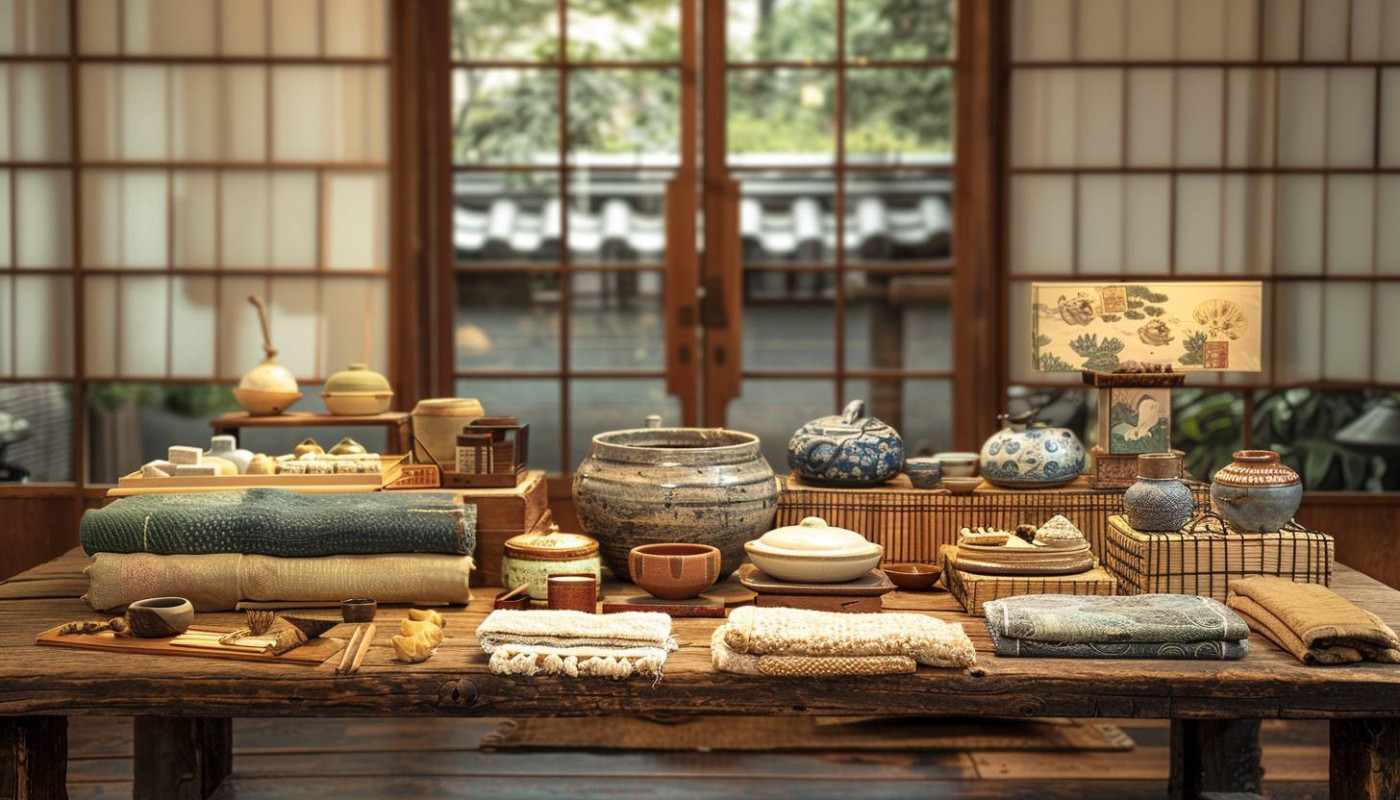Table of contents
Dive into the rich tapestry of Japanese heritage where ancient artistry meets modern convenience. Traditional Japanese crafts offer a window into a culture steeped in meticulous craftsmanship and attention to detail. This exploration invites aficonados and newcomers alike to discover the seamless blend of time-honored skills with the accessibility of contemporary e-commerce platforms, opening a world of cultural treasures to a global audience.
Reviving Ancient Techniques Through Online Markets
The digital realm has opened new horizons for the appreciation and distribution of traditional Japanese crafts, marking a notable resurgence through e-commerce platforms. By leveraging the global reach of these online marketplaces, skilled artisans have found a vibrant, borderless avenue to showcase their creations, from intricate textiles to delicate ceramics. This burgeoning digital trend not only bolsters the visibility of authentic Japanese handicrafts but also plays a pivotal role in the preservation of intangible cultural heritage. Artisan marketplaces on the web serve as conduits between the rich legacy of Japan's craft traditions and a diverse international audience, ensuring that time-honored techniques continue to thrive in the modern world.
Furthermore, the propagation of Japanese crafts online extends beyond cultural preservation; it injects vitality into local economies. As artisans gain access to a broader consumer base, they receive essential support that enables them to sustain their livelihoods and, in turn, continue the practice of their craft. This development is of immense significance to both the individuals and the communities involved, fostering sustainable craftsmanship and economic resilience. The movement toward craft revival through e-commerce platforms is thus a multifaceted phenomenon, enriching cultural understanding and providing tangible benefits to societies dedicated to maintaining their artistic heritage.
Connecting Artisans and Consumers Directly
The advent of e-commerce platforms has revolutionized the way traditional Japanese crafts are marketed and sold, effectively bridging the gap between artisans and a global audience. These platforms serve as a direct-to-consumer channel, eschewing traditional supply chain complications and allowing for an authentic artisan-consumer connection. Transparency in craft is significantly enhanced as consumers gain immediate insight into the creation process, the materials used, and the cultural heritage behind each item. Storytelling becomes a pivotal aspect of the buying experience, transforming a simple purchase into a personalized shopping experience replete with history and meaning. This intimacy not only supports the talent of skilled artisans but also fosters a personal connection that often leads to customer loyalty and brand advocacy. In many ways, these online marketplaces have become a lifeline for preserving the intricate artistry and traditions that might otherwise be lost in a world of mass production. For a deeper dive into the vibrant world of Japanese craftsmanship and the unique stories each piece holds, click to read more.
Ensuring Authenticity in a Digital Marketplace
One of the challenges that surfaces when traditional Japanese crafts are made available on e-commerce platforms is the preservation of authenticity and maintaining the high-quality standards these artifacts are known for. In response to this concern, various e-commerce platforms have adopted stringent quality assurance measures. These measures are designed to safeguard product authenticity and, in turn, fortify consumer trust. Authentication protocols play a pivotal role in this process, serving as a rigorous vetting mechanism that verifies the origin and craftsmanship of the products.
To ensure that customers receive authentic Japanese crafts, several platforms require sellers to provide detailed provenance information and craftsmanship certification. This certification often includes the craftsperson's background, the techniques used, and the materials’ source. By meticulously auditing these details, e-commerce platforms aim to create a transparent digital marketplace where the heritage and integrity of Japanese craftsmanship are preserved. Such measures demonstrate a commitment to quality assurance that resonates with consumers who are increasingly conscientious about the authenticity of the items they purchase online.
The trust of consumers is further reinforced by user reviews and ratings, which provide social proof of the products' authenticity. Moreover, advanced authentication protocols may include periodic checks of the sellers and crafts, as well as partnerships with Japanese craft associations that can certify the authenticity of traditional items. These collaborations serve as a bridge between the old and the new, ensuring that traditional Japanese crafts can be enjoyed by a global audience without compromising the authenticity that makes them truly special.
Sustainable Practices and Eco-Conscious Crafting
In the realm of traditional Japanese crafts, the principle of sustainable crafting is deeply woven into its cultural fabric. E-commerce platforms have become pivotal in promoting these eco-friendly practices, championing the use of eco-friendly materials and traditional techniques that reflect a commitment to sustainable development. These online marketplaces not only provide a global audience for artisans but also emphasize the low-impact methods inherent in Japanese craftsmanship. The materials sourced are often local and renewable, aligning with environmentally conscious values and reducing the carbon footprint associated with production and distribution.
Moreover, the durability and long-lasting quality of these crafts underscore the movement towards craft sustainability. Each item is created with the intention of enduring use, a stark contrast to the disposable culture prevalent in mass production. The expert guidance of environmental specialists focusing on sustainable practices in the arts and crafts sector reinforces this narrative. They advocate for the preservation of such heritage crafts, ensuring that they continue to be synonymous with resilience and sustainability in a modern marketplace.
Embracing Technology to Preserve Tradition
The intersection of technology and tradition may seem contradictory at first glance, yet it is through modern advancements that traditional Japanese crafts are finding new life and audiences. The use of sophisticated tools and platforms enables artisans and educators to preserve these time-honored practices while making them accessible to a global community. Digital showcasing of crafts has become a pivotal method for artisans to reach an international market, allowing the beauty and intricacy of their work to be appreciated far beyond local boundaries.
In the realm of 'technology in crafts', digital preservation strategies play a key role. By documenting techniques and designs in high-quality digital formats, the details of these traditional arts can be safeguarded against the eroding effects of time. Such strategies are usually devised by specialists in digital humanities, those with an expertise in both technological and cultural preservation. These experts help ensure that the knowledge and heritage embedded in crafts are not lost, but rather, are kept alive and vibrant for future generations to learn and draw inspiration from.
Interactive craft platforms have emerged as hubs for crafts education, where anyone with internet access can learn about the history, techniques, and cultural significance of these crafts. Whether through online workshops, detailed tutorials, or virtual reality experiences, these platforms provide a hands-on approach to understanding and appreciating the subtleties of Japanese craftsmanship. As a result, they not only promote the perpetuation of these crafts but also inspire new waves of artisans who can carry on the traditions with a blend of respect for the old and enthusiasm for the new.
On the same subject

Key Advantages Of Using A White Label Solution In Online Gaming

Exploring The Rise Of Low Deposit Options In Online Gaming

Exploring The Benefits Of Welcome Bonuses In Online Gaming Platforms

Exploring The Popularity Of Animal-Themed Casino Games

Comparative Analysis Of PC Games Adapted From Iconic Comic Series

Exploring The Legality Of Binary Options Trading Worldwide

Mobile Compatibility: A Must-Have For Modern Online Casinos

Exploring Effective Tactics For Enhancing Personal Connections And Hobbies

Exploring The Benefits Of Online Casino Bonuses And Promotions

Exploring The Benefits Of Innovative Digital Spinning Platforms

Maximizing Your Benefits With Welcome Bonuses And Free Spins

How To Maximize Winning Chances On High Volatility Slots

Personal Stories Of Winning Big In Australian Online Casinos

Exploring The Future Of Online Gaming And Technology

Exploring The Thrill Of A Virtual Road-Crossing Casino Game

Playing Road Crossing Games On Mobile: Tips And Tricks

Strategies For Maximizing Winnings In Online Plinko Games

Exploring The Benefits Of Low Deposit Options At Online Casinos

Exploring The Benefits Of Generous Sign-Up Bonuses In Online Gaming Platforms

Exploring The Thrills Of Online Casino Bonuses: How To Maximize Your Gaming Experience

Exploring The Excitement Of Free Play Casinos: Strategies, Bonuses, And Winning Big

The Rise Of Mobile Gaming: How Smartphones Have Transformed The Online Casino Experience

The Influence Of Fallout: New Vegas' Casinos On Modern RPG Design

The Psychology Behind Welcome Bonuses: What Attracts Players To New Casino Sites?

